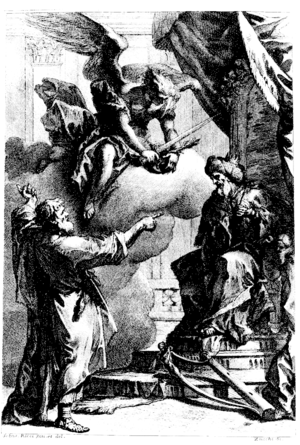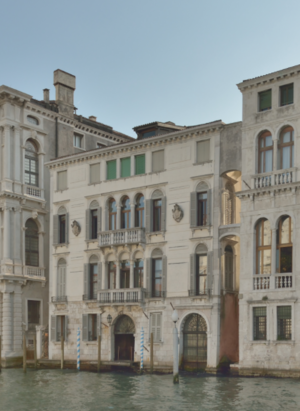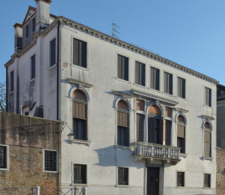Marcello Psalms
Marcello's Psalms of David constitute an unusual chapter in the history music. They are widely misunderstood to be sacred works. Based on poetic texts by G. A. Giustiniani, they were collectively published under the title(s0) Estro poetico-armonico: parafrasi sopra li primi [e secondi] venticinque salmi di Davide, the works appeared in eight volumes issued between 1724 and 1726.
The Psalms were not intended to be religious works. They fitted squarely into In the composer's mind they were secular works intended to enhance discussion of literary and intellectual themes popular in Arcadian circles. All of them had their debut performances at academic gatherings. Musically, they are atypical of the larger culture in which they existed, where opera and chamber music predominated. Yet they are also highly intricate works that reflect in their musical construction the elaborate poetic schemes of David's psalmistry.
God, Man, and Arcadian Values in the Eighteenth Century
The Psalms of David that were published in Venice in eight folio volumes (1724-1726) bring into convergence an array of approaches to composition. Yet all of them pursue a single goal: to suit the antiquity of the subject to allusions to antiquity in the music. Marcello was precocious in adopting this aim. He was a leader among Venetian noblemen in the breadth of his intellect and the depth of his commitment to Antiquarianism. Peter Gay's term "pagan Christianity" (which applies to an impetus of the time) sums up Marcello's methods of appealing of the sensibilities of other enthusiasts of neoclassical culture.

We can see from Sebastiano Ricci's stern depiction of God in the frontispiece of Book III (1724) that Old Testament justice could be harsh. Yet the Psalms that that describe David's prayers and his pleas for mercy provide sharp contrasts for the menacing scenes of fear and efforts to escape God's wrath. Dramatically, the Psalms fluctuate in mood. The notion of a pagan Christianity aptly characterizes the way in which Marcello makes his evocation of the fluctuating relationship of Man to God. His treatment reflects rising interest in classical archaeology and the ancient models of art and literature to which is brought attention. The Biblical figure of King David was known as an articulate poet and a moving orator, although many Psalms express is desolation and supplication.
Psalm Categories and their Vernacular Translations
Like Marcello, Girolamo Ascanio Giustiniani (1677-1732), who composed the vernacular setting of the Psalm texts, was a nobleman. As mayor of Padua (1703), he was well known on the mainland. Giustiniani was the dedicatee of Francesco Gasparini's L'Armomico pratico al cimbalo (1708), a practical manual on keyboard accompaniment. His daughters were harpsichord students of Marcello's. The Giustiniani had a modest palazzo on the Grand Canal in the parish of San Barnabà between the Ca' Rezzonico (today a museum) and the Ca' Foscari (today part of the university).

Theologians divide the Psalms of David (of which Marcello set only about one-third) into several thematic cateogories including kingship, the holy city of Zion, songs of trust, songs of thanksgiving, laments, songs for royal feasts (e.g. weddings), meditations on life ("wisdom" songs), and commemorations of historical events. In common with the Pentatuch (the first five books of the Bible), the Psalms are divided (unequally) into five sections but the works are not grouped thematically. However each set closes with a doxology. The works are said to be grouped in five "benedictions": 1-41, 42-72, 73-89, 90-106, 107-150 (Roman Catholic numbering). The scheme may have originated with the editors of the Torah. Over centuries many textual tropes accrued to individual psalms. (The complexities of Psalm numbering systems are explained here.)
Why exactly Giustiniani and Marcello decided to present only 50 of the Psalms is unknown, but two important considerations are evident. Each composition was a significant work in its own right. Also, the number 50 had its own liturgical considerations. In Christianity Easter is framed by two periods of 50 days each. The first of these markers begins "the great fast" (Lent), the last recognizes the feast of Pentecost.
The Psalms are ripe for musical treatment insofar as many of them contain musical references to performers (leader, choirmaster), instrumentation (with stringed instruments, with harp), or liturgical function.
The Terrestrial Network of Psalm Admirers
Marcello was a master of networking in the Arcadian Academy, a network of noblemen and women committed to certain ideals of ancient Greece. Much of pastoral imagery in art and music reflected this stance. The primary instance of Arcadia issued from the hills of the Janiculum in seventeenth-century Rome. Upon her passing, many cities of the Italian peninsula established their groups who explored poetry and music through verse, cantatas, and serenatas. Leading figures in Rome were Arcangelo Corelli and Bernardo Pasquini.
In planning their publication (in eight handsome foglio volumes issued by Domenico Lovisa, 1724-26), Marcello took the unusual step of soliciting testimonials from leading composers, music masters, and noted poets and dramatists. He included a few of these testimonials in each volume.
Among the respondents, the best remembered today are Johann Mattheson (1681-1764), the Hamburg Kapellmeister who was also a prolific writer on music, and Georg Philip Telemann (1681-1767), Hamburg's most prolific composers. Eminent Italian composers included Francesco Gasparini (1661-1727), the maestro di cappella of Santa Maria Maggiore in Rome, Geminiano Giacomelli (1692-1740) (Piacenza), Domenico Sarri (Naples), Antonio (1677-1726, Modena) and Giovanni Bononcini (1670-1747, London), and the Italian emigrant composers Francesco Antonio Conti (Vienna) and Stefano Andrea Fiorè (Turin). The rest (including Domenico Lazzarini and Girolamo Ascanio Giustiniani) were poets and dramatists who were committed to the same ideals as Marcello.
Musical Allusions to Ancient Cultures

The most eye-catching feature of several of Marcello's Psalm settings was the inclusion of facsimiles from traditions of worship in Antiquity (or what was then understood to be ancient). These quotations are confined to Books II, III, and IV (all 1724). Marcello was careful to distinguish an array of different liturgical traditions and, although he was very learned, his examples all seem to have been found in Venice. The Marcello family's modest palazzo (next to the Ca' Vendramin-Calergi, where Richard Wagner later died) was very close to the Ghetto, which was itself divided into an Old Ghetto (to the north) and a New Ghetto (close to the Grand Canal).
The divisions that interested Marcello were its three Jewish traditions--Ashkenazic (Pss. 15, 17, 19, 21, and 22), Sephardic (Pss. 16, 17, and 18), and Levantine. The German Scola (synagogue) was in the New Ghetto. In Marcello's time it was larger than the other two (in the Old Ghetto). Israel Adler had shown that the earliest exemplars of some of the melodies used by Marcello have no documented history before the the seventeenth century. More recently Don Harran and Edwin Seroussi have mapped the repertories of Marcello's cache of "ancient" chants onto broader terrains of cultural and musical dispersal. Apart from his Jewish exemplars, Marcello also used intonations from the Roman Catholic liturgy of his time, and a Greek text said to be Dionysius' Hymn to the Sun. Marcello sometimes embedded excerpts from different traditions in the same psalm. His decisions were made on a verse-by-verse basis.
Renaissance Counterpoint in the Psalms
No one questions Marcello's sincerity in trying to embed these symbols of ancient culture into new compositions that honored musical traditions that dated to the sixteenth century. He drew of ostinato basses, contrapuntal practice from the time of Palestrina, and other allusions to older methods of setting text. Some of Marcello's interest in contrapuntal technique was carried over from earlier studies the results of which are already reflected in his madrigals for three and four voices.
Subsequent Editions and Adaptations
Through the year 2013, at least 23 complete editions of Marcello's Psalms of David have been published. Only three of these reissues (1776, 1803-05, 1835) come from Venice. The first foreign edition was published in Prague (1729), then in Rome (1739). Parisian prints of the nineteenth century seem to have prompted the interest of Cherubini, Rossini, Paer, and Bizet. Giustiniani's texts have been translated in German, French, Swedish, English, Czech, and Church Latin (for ecclesiastical use).
England
The Newcastle organist Charles Avison (1709-1770) was the greatest champion of Marcello's Psalms in England. He labored intensely in the preparation of the eight-volume edition published by John Garth, the organist of Durham Cathedral, in 1757. Avison provided a biography of Marcello in the first volume. "The Psalms," Avison wrote, "are so excellent, and the great and affecting touches of nature and art so numerous, that few subjects of censure will be found. They appear to me fraught with every musical beauty." Above all, Avison found the harmonies of the works their outstanding quality. As a composer of concertos, Avison had a direct interest in the harmonic aspects of music. His Essay on Musical Expression (1752) was the first of its kind in English. He was an enthusiast of Italian music styles.
The Psalms in the Context of Marcello's Oeuvre
Benedetto Marcello was physically distant but intellectually close to Rome's Arcadia. He strove to express Arcadian values in music. His 379 cantatas for solo voice, almost 100 for two voices, and various works for 3-5 voices were intended for performance at weekly gatherings of individual colonies. The social practice underlying these gatherings waned in Italy by 1750, but his secular music found its way into other assemblies all over Europe, where it enjoyed respect through much of the nineteenth century.